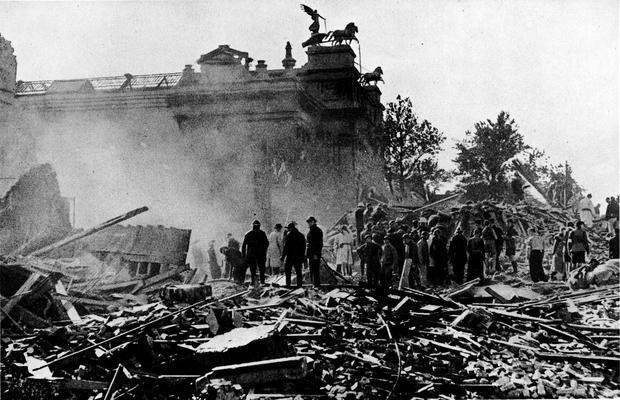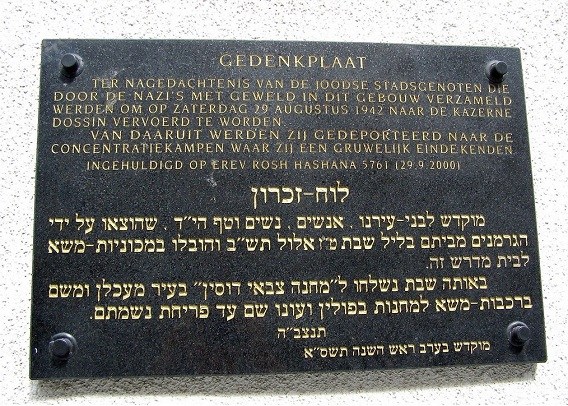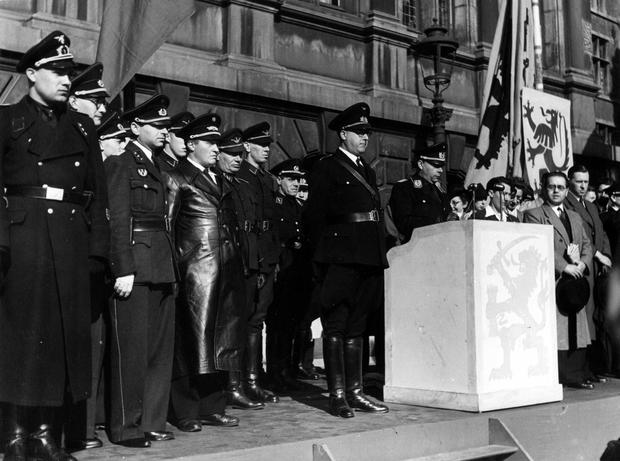Historian Herman Van Goethem, rector of Antwerp University and a former director of Kazerne Dossin, the Holocaust and Human Rights Museum in Mechelen, spent 14 years of his life writing a book about Antwerp during 1942.
The book – in Dutch “1942, Het jaar van de stilte” or “1942, The year of silence” – refers to the year when Belgian authorities kept silent about the Nazi persecutions of Jewish people, and when some on the local level collaborated willingly with the occupation force.
The book is a stark reminder of the Nazi-German occupation of Belgium and a warning to contemporary society against the dangers of discrimination, segregation, dehumanisation and the expulsion of minority groups, leading ultimately to crimes against humanity and genocide. Until the end of WWII, these crimes were not even defined and governments were allowed to treat their inhabitants as they liked without any outside interference.
In December 1940, Jews aged 15 years or older who lived in Antwerp were already forced to register with local authorities. The town council actively cooperated, calling on Jews in the city to register and administering the registration. Police officers helped draw up the lists. As of 29 July 1941, all Jewish ID cards were stamped with the word ‘Jood-Juif’.
In June of 1942, all Jews aged six years or older were forced to wear a yellow Star of David. The administration drew up lists of all Jews who had not collected their star and distributed approximately 15,000 of them.
This gradual and all the more violent segregation process, abetted, particularly in Antwerp by the local administration, resulted in the deportations of 25,250 Jews and 352 Roma from Belgium, in 26 train transports from former military barracks in Mechelen to the death camp in Auschwitz. The last one was on 31 July 1944, just days before the liberation of Belgium.

Jewish girls in De Keyserlei, Antwerp, wearing yellow Stars of David. Credit: Holocaust Museum, Mechelen.
In 1942, Nazi-Germany was still victorious and had conquered most of Europe. Belgium, whose government was in exile in London, was not alone in believing that it was an option to adapt the country to the new European order, at the expense of its own constitution and respect for human rights.
Renaming of harbour dock
The book sheds new light on the controversial role of Catholic alderman for the city harbour, Leo Delwaide (1897 – 1978), who acted as mayor of Antwerp during most of the war years (December 1940 – January 1944). The revelations have already led to the renaming of a dock in the harbour of Antwerp from “Delwaide Dock” to “Liberation Dock”.
Johan Vermant, a spokesman for Bart De Wever, the current mayor of Antwerp and leader of the N-VA party (New Flemish Alliance), tells The Brussels Times that the renaming was just one of many measures by the city government to keep the memory of deportation, occupation and liberation alive.
Antwerp was liberated on 4 September 1944 but the war was far from over. Of all the Belgian cities, Antwerp was the hardest hit during the German bombardment with flying bombs and rockets. Historians estimate that some 3,000 civilians were killed in Greater-Antwerp during six months. An additional 600 Allied soldiers also died. Just over 5,200 people were injured or reported missing.

Royal Museum of Fine Arts, Antwerp, hit by German fighter plane, 13 October 1944.
“Van Goethem’s book in that sense gave us the final answer,” Vermant said. “We could not continue to name a prominent dock in our city after Delwaide knowing that there are still witnesses, victims and their families among us today. To set an example for future generations, we chose the name Liberation Dock.”
The name change will be made official in September during the traditional Liberation Days to honour all the victims of the occupation, the deportations, the liberation and the V-weapon attacks during the final months of the war. The dock is enclosed by quayside companies and can currently only be reached by boat or private access.
Complicity in genocide
The Brussels Times interviewed Professor Van Goethem about his book. I started by asking him how he explains Delwaide’s collaboration with the occupation force during the war. Was he known for his anti-Semitism?
“Not as far as I know,” he replied surprisingly. Putting it mildly, it might be explained as a policy of least evil. “But no doubt he was complicit in exposing the Jews to great danger – how great wasn’t known at the time – by cooperating with the Nazi in violently rounding up the Jews in Antwerp for transport to an unknown destiny in the east of Europe.”
More than 10,000 Jews were deported from Antwerp in 1942, the majority of them non-Belgian citizens and refugees from other countries in Europe. In Belgium, a total of 18,000 Jews were deported in 100 days in 1942, followed by 8,000 in the following years. Many of them were betrayed by locals or by their supposed protectors as soon as the money ran out. A large number of Jews were active in the Belgian resistance.
Just under 10% of the Jews in Belgium before the war were Belgian nationals. About 3,000 of them were deported in August – October 1943 by the Nazis in their frenzied, murderous search for all Jews. By that time many of the Jews had went into hiding. The Belgian authorities might have consciously sacrificed non-Belgians in the mistaken belief that Belgian Jews would be exempted from the deportations.
As mayor, Delwaide was also chief commander of the local Belgian police. While there is no evidence that he personally participated in the raids, he did prepare the ground for them through organisational measures. During his research, Van Goethem came across new, previously unknown, facts.
Reorganisation of police force
A preview of the violence to follow took place on Easter Monday, 14 April 1941, in the “Jewish” 6th district near Antwerp’s Central Station. The violence erupted after a screening of the propaganda film Der ewige Jude by the radical anti-Jewish group Volksverwering. Hundreds of Antwerp residents and Germans joined a veritable pogrom, destroying the home of a rabbi and setting synagogues on fire.
Early on, the Nazis must have discussed the deportations with the city’s authorities. In March 1942, a new police school was opened and in a very short time, just in time for the round-ups of the Jews, new pro-German, brutal policemen were indoctrinated and trained, wearing new black uniforms. They were involved in the following round-ups.

Summer 1942: Kazern Dossin, the transit camp in Mechelen, after the arrival of those caught during the night. Credit: Holocaust Museum, Mechelen.
Delwaide also provided a public building in Antwerp, guarded by local armed police, to be used as a transit area in the deportations. Later on, the military barracks in Mechelen were to be used. Just before the first razzia on 22-23 July 1942, Delwaide decided to reorganise the local police force, ensuring that pro-German police would serve in the district, where most Jews lived. He also appointed a pro-German police chief to take command in the district.

Leo Delwaide, second from the left, next to Jan Grauls, governor of the province of Antwerp.
Another extraordinary circumstance is that Delwaide personally sanctioned those few police officers who refused to obey orders to carry out the round-ups of Jews. They were summoned to city hall where Delwaide punished them by deducting a few vacations days and entering a remark in their personal file that could have affected their career prospects.
“Delwaide worked out the framework for the round-ups in the most effective way,” Van Goethem said. “We know that he was informed about the deportations, decided on the reorganisation of the police force, and sanctioned police officers that didn’t obey orders. But this wasn’t exceptional for Antwerp. It happened in several cities in occupied Europe.“
The Nazis were masters in cultivating fake news about the real purpose of the deportations and luring the Jews into a false sense of security. Van Goethem mentioned that in December 1940-February 1941, some 3,000 Jews and other foreigners had been deported by Antwerp police to forced labour in Limburg in the eastern part of Belgium. They were later released and allowed to return to Antwerp.
Structured as a diary
How did Delwaide’s family react to the new findings in the book? “I haven’t heard from them this time,” replied Van Goethem. “In the past they tried to file defamation charges against me and other authors, who claimed that Leo Delwaide collaborated with the Nazi occupation force.”
Knowing Van Goethem’s decisive role as curator and the first director of the Holocaust museum in Mechelen, I asked him if the book was linked to the museum and based on its material and documentation.
”I started to work on the book in 2005, before I became engaged in the museum,” he said. “The museum is a by-product of the book. I based the book on studies of the police archives in Antwerp, among the biggest in Europe. The overall question I asked myself was how the mass violence in the deportations by the local police was made possible.”

Historian Herman Van Goethem, author of “1942, The year of silence”.
Talking to Van Goethem, you get the impression that writing and finishing the book were his main occupation during 14 years. One personal explanation for his passion might be, as he discloses during the interview, that his grandfather was mayor in a small municipality outside Antwerp and complicit in the deportation of communists. He also tells his own family story in the book.
“I’m using the structure of a diary in the book,” he explained. “I write about the victims in present tense. No person or dialogue in the book is invented. In a flash-forward, I’m also interviewing people still alive with memories from 1942, e.g. a person who was teenager and the only member of a resistance group that survived. His own father was a police officer, who participated in the deportations.”
Van Goethem emphasises that he has a source for everything in the book. Although the book reminds the reader of a documentary novel, it is as well-researched as a historical thesis, including footnotes. It is too early to say how other Holocaust researchers will respond to the book, since it has not yet been translated into English. He hopes that there soon will be an English edition.
Beyond Antwerp
The book goes beyond just dealing with events in Antwerp and has a wider perspective in reassessing the strategies of the Allied powers in the war, said Van Goethem. His book ends with an epilogue consisting of a number of statements with a central reference to the idea of a separate compromise peace, which was still floating around in 1942.
“Most of us have just two images when thinking about the war – Auschwitz where more than a million Jews and other people, Poles, Roma and Soviet war prisoners, were killed, and D-Day when the Allied forces landed on the beaches of Normandy,” Van Goethem said.
“But Auschwitz wasn’t known to the outside world in 1942, and no-one could foresee how the war would end,” he said. “1942 was a bad year for the Allied powers. It would take the defeat of Rommel in November 1942 at El Alamein in North Africa to show that the Germans weren’t invincible. Until then, both the Belgian and Dutch exile governments in London kept silent.”
According to Van Goethem, until the end of 1942 even Roosevelt and Churchill might have contemplated a negotiated European peace in case the German military would overthrow Hitler. The evidence that can be found is generally ignored, due to the absence of this focus in historical research. Goebbels writes in his private diaries that Churchill tried several times to enter into contact with the Germans. Until November 1942, the US still maintained diplomatic relations with the French Pétain regime in Vichy.
In hindsight, this seems all wishful thinking. The German military, the Wehrmacht, obeyed Hitler’s orders to the very end and paved the way for the mass killings in the eastern front after the invasion of the Soviet Union.
Only in November 1942, did the Belgium government in exile distance itself clearly from the policy of administrative collaboration with the occupation force, by making clear to which extent local administrators would be punished after the war.
The change in the international context was immediately visible on the ground. Van Goethem mentioned Deurne, a district in Antwerp, whose police force had carried out round-ups of the Jews. The same police officers then became resistance fighters. Later on, 43 of them were sent to a concentration camp, where 35 of them died.
The Belgian government would later claim that it did not really know what was happening in occupied Belgium. But Van Goethem said that this is not credible. Throughout 1941-1942, month after month, Belgians who had fled the occupied country, including politicians and prominent figures, arrived in London and informed the exile government.
Allied condemnation without action
In the summer of 1942, Jan Karski, a brave Polish officer and diplomat, toured the Warsaw ghetto and saw first hand the results of the deportations and the Nazi-German extermination policy. He also visited eastern Poland and scouted in the vicinity of the Bełżec death camp.
On his return to London in November 1942, Karski informed the Polish government in exile, which on 10 December 1942 formally appealed to the Allied governments to speak out against the extermination of the Jews.
This resulted a week later in an Allied declaration that, for the first time, condemned the Nazi “bestial policy of cold-blooded extermination” and threatened to “ensure that those responsible for these crimes shall not escape retribution”.
In practice, however, not much was done to stop the genocide and save any surviving Jews. The war against the Nazi-German armed forces took precedence, and any plan to bomb the extermination camps was seen as a distraction and never carried out.

Memorial sign in Dutch and Hebrew at Terlint Street 33, Antwerp. Jews were brought on trucks to this building before they were sent to Kazerne Dossin in Mechelen on 29 August 1942 and from there on goods vans to their death in Auschwitz. The memorial was erected on 29 September 2000 and mentions the Nazi-German perpetrators without mentioning the collaboration of local Belgian police.
In Antwerp, the resistance started to secretly resist and sabotage the German orders. Unfortunately, this came much too late for many Antwerp Jews who had already been arrested and deported. After the war, people only wanted to remember the heroic resistance period starting at the end of 1942. They did not want to be reminded of the period of active compliance with the occupation, which turned out to be fatal for so many Jews.
Van Goethem spoils the party when he reminds Antwerp that it has something to be proud about and much to apologise for. His book comes in the wake of another recent book by Flemish writer Jeroen Olyslagers. In his devastating novel “Wil”, published in 2016, an old retired police officer tells his great grandson what he did in Antwerp during the war, and how he tried, unsuccessfully, to stay clean.
He calls himself “tweezak”, Dutch for an opportunistic coward who tries to please two sides. The book was awarded the Libris Literature Prize 2017 as one of the two best Dutch-language books of the previous year.
“The extremely compelling and engaging book by Jeroen Olyslaegers differs significantly from conventional novels about the Second World War,” said the Libris jury. “In Wil, there is no battle between good and evil and no sign of a morally superior character or writer with the benefit of hindsight. Instead, it’s an attempt by an old man full of doubts to account for his role in the occupation.”
In an interview, Olyslaeger acknowledged that he had been strongly influenced by Herman Van Goethem for repeatedly pointing out to him the grey zones in the occupation and their historical importance. “My book is about how quickly a bureaucracy begins to exhibit psychopathic characteristics, and how quickly officials simply act as if it’s normal, knowing well that it’s not,” Olyslaegers said.
| Compelling reading Antwerp mayor Bart De Wever, himself an historian by training, describes Van Goethem’s book as a masterpiece and found the book compelling. “As mayor, I would like to thank Herman Van Goethem on behalf of the city because he has enriched Antwerp with this work. He has written about one of the blackest pages in our history with great professionalism and personal passion. What happened in 1942 can never be forgotten, distorted or minimised by whitewashing.” The leader of N-VA, a Flemish nationalist party with roots in a separatist movement in Flanders where some elements cooperated with Nazi-Germany, is frank and unambiguous about the lessons of history: “One can quite rightly point to a widespread and old anti-Semitism in Europe as explanatory circumstances. It’s sufficient to go through the Gazet van Antwerpen (a Catholic newspaper) of the interwar period. One can also point to the occupation and the war circumstances. One can point to the contemporary ignorance of many actors.” “But one cannot ignore the fact that many people in town and country showed great opportunism towards the occupiers as long as it seemed that they were going to win the war. And that many felt little or no involvement with regard to the fate of the Jewish population, in particular concerning the many foreign Jews who had taken refuge with us.” “The acknowledgement of the bitter truth is that evil didn’t simply descend upon us and that it dragged many people into its whirlwind. It is necessary to connect past and present in a true alignment for a better future,” said today’s mayor of Antwerp. |
By Mose Apelblat

